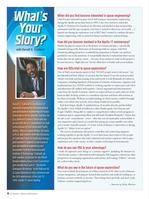Barrett S. Caldwell is a professor of industrial engineering and aeronautical and astronautical engineering at Purdue University in West Lafayette, Indiana. He is a Jefferson Science Fellow and has served with the U.S. Department of State in the Bureau of of East Asian and Pacic Affairs, Office of Japan Affairs. He holds a PhD and master's from the University of California-Davis in social psychology, and bachelor's degrees in aeronautical and astronautical engineering and humanities from the Massachusetts Institute of Technology. Caldwell, an Institute of Industrial & Systems Engineers (IISE) member, is director for the NASA-funded Indiana Space Grant Consortium and recently took part in “The Apollo Dialogues Workshop” at the National Air & Space Museum to help commemorate the 50th anniversary of the July 20, 1969, Apollo 11 moon landing.
When did you first become interested in space engineering?
I first became interested in space travel and aerospace/astronautics engineering during the Apollo moon shots back in 1968. I was very excited to watch the Apollo 8 Christmas Eve broadcast on television and decided at that moment that astronautics and the space program were how I wanted to direct my career path. ... I figured out during my sophomore year at MIT that I wanted to combine the space systems engineering with an interest in human performance and psychology.
How did you become involved in the Apollo 11 anniversary?
Purdue has played a major role in the history of aviation and space. I specifically remember being at the dedication of Armstrong Hall on campus, with Neil Armstrong talking about how wonderful his preparation at Purdue was and how grateful he was to the university. It was probably that day I realized that there was no better place for me and my career. ... Because of my passion to work on the project, I became known as “flight director” for the effort here at Purdue and across Indiana.
How are ISEs vital to space exploration?
One of Neil’s most famous quotes is that “400,000 people went to the moon,” not just himself and Buzz Aldrin. It’s not just that the Saturn V was the most powerful vehicle ever built and functioning (even until now); it took thousands of contractor companies, including hundreds of thousands of scientists, technicians, engineers and mathematicians (yes, STEM workforce) working together to ensure parts and valves and subsystems all worked well together. Critical organizational demonstrations come from the Apollo 8 mission, which was replaced from an earth orbit test of the lunar module docking systems to a translunar injection and lunar orbit mission in less than six months. Without an understanding of which systems could be brought online over which time periods, such a thing would not be possible. And don’t forget, Apollo 11 splashed down 30 months after the pad re killed the Apollo 1 crew (which included two other Purdue grads, Gus Grissom and Roger Chaffee). Being able to conduct a comprehensive failure review program re-evaluation and re-engineering effort and still make President Kennedy’s “before this decade is out” commitment – twice – after that sort of catastrophic system failure is very impressive and is based on a model that giving up is unacceptable even when
you’ve made a horrible mistake. Or in the words of Mission Control then or during Apollo 13, “failure is not an option.”
The success of astronauts and mission controllers and contracting engineers working together to get the Apollo 13 crew back home shows that it is the people and not just the equations that make industrial and systems engineers vital to space exploration and a wide variety of other complex technological environments.
How do you use IISE to your advantage?
I really do approach most things as a systems engineer, including the humans involved in the systems. I often nd myself reading the ISE magazine columns for other perspectives on managing organizations and systems, and reading “Dilbert” cartoons for a sober reality check.
What do you see in the future of space exploration?
If we were to think about humans on a Mars mission by 2040, there is a lot of human-systems integration, and purpose-focused data analytics and artificial intelligence as partners, not just overlords or servants. These things don’t get built, and don’t work, without a systems engineering focus.

